Smadhi of Maharaja Jassa Singh Ramgarhia
<< ARTICLE MOVED >>
This post by S. Gurdev Singh Rooprai has been moved to his BLOG: http://www.gurdevsingh.in/smadhi-of-maharaja-jassa-singh-ramgarhia/
This post by S. Gurdev Singh Rooprai has been moved to his BLOG: http://www.gurdevsingh.in/smadhi-of-maharaja-jassa-singh-ramgarhia/
Originally posted in NRI Achievers Magazine
As the Sun travels towards south on the celestial sphere, the Dakshinayana Period is observed as per ancient Indian philosophy. This period starts from Karka Sankranti (Cancer) on July 16 and goes till January, which is celebrated as Makar Sankranti (Capricorn). In western world, this transition from Dakshinayana to Uttarayana is known as Winter Solstice. In simpler words, Winter Solstice is the shortest day and longest night of the year. This event is celebrated across globe and all ancient cultures mark it as one of the most important days of the year. Let’s have a look:
It has been proven that the Stonehenge in England and Newgrange in Ireland have their primary axes carefully aligned on a line of sight pointing to winter solstice Sunset and Sunrise respectively. These monuments were sites of worship and celebration.
In Northern Europe, a 12-day winter solstice is celebrated in form of a festival called ‘Yule’. Many modern day Christmas traditions and practices are inherited from this festival.
Traditionally, the Winter Solstice in European region is celebrated on 25th December. In Asia, it is celebrated few weeks later, on 13th/14th January. This period is also the period of harvest and of utmost importance for all cultures, that depend on agriculture.
The Julian calendar starts from 14th January and the Russian Orthodox church still celebrates it as the Old New Year. This Julian new year, aka Orthodox new year is also celebrated in many European & African countries including Serbia, Kosovo, Bosnia, Belarus, Uzbekistan, Georgia, Azerbaijan, Kazakhstan, Montenegro, Moldova, Ukraine, Wales, Switzerland, Scotland, Herzegovina, Morocco, Libya and Montenegro. In many regions, it is also known as Little Christmas. Traditions in some of these countries are similar to how we celebrate in South Asia, especially the Bonfire.
Now let’s talk about South Asia. Being primarily into Agriculture, this festival of Harvest is one of the most important festivals in region. Hindu Tradition celebrates this date as Makar Sankranti. The Punjab region calls it Maghi. Instead of celebrating it on exact date of Winter Solstice, festival is observed on the last day of month, in which Winter Solstice occurs. Technically, this celebration is the passing of winter solstice and harvest. Maghi or Makar Sankranti is also seen as the start of new financial year. The new year’s eve is celebrated as Lohri in North India. If we look at the geographic position of North India, 13th January is the day every year, after which sunrise starts to happen earlier every morning until June, when this cycle reverses.
Global Economy used to rely on Barter System for ages. My mother tells me that her grandfather used to repair tools and equipment used by farmers. For most of the repairs, he was not paid. But during harvest, every farmer in village would come to gift a share of their crop. There were special store rooms and silos, where this harvest was kept. The extra stuff was sold to get money for rest of the year and silos were always full for food till next harvest season. In such happy times, it was obvious that many traditions were born. For example, before Lohri, children would go from door to door asking for treats. Kite flying, participating in fairs and dance is the most common of all. Since the Lohri night would be the longest night of year, everyone would gather around a bonfire and spend time singing, dancing, celebrating and hoping for better time ahead.
As we know, men used to work in farms. A boy born in any house that year becomes more important for families, as he would grow up to support in Agriculture. Lohri slowly became a festival, where families would celebrate the birth of a boy. The tradition still continues.
Sunder mundriye ho! Tera kaun vicharaa ho!
Dullah Bhatti walla ho! Dullhe ne dhee vyayae ho!
Ser shakkar payee ho! Kudi da laal pattaka ho!
Kudi da saalu paata ho! Salu kaun samete ho!
Chacha gaali dese ho! Chache choori kutti ho!
zamidara lutti ho! Zamindaar sudhaye ho!
Ke Gin Gin bhole aaye ho!
Ek bhola reh gaya! Sipahee far ke lai gaya!
Sipahee ne mari itt! Bhaanvey ro te bhaanvey pitt!
Sanoo de de Lohri, te teri jeeve jodi!
This festival of harvest is known with different names in different parts of the country. From Pongal to Bihu and from Bhogi to Lal Loi, the celebration of winter solstice has its own charm and different folklores to tell. The stories shall remain alive in our hearts, as long as we continue to embrace our past.

Most religions originated from India consider 108 as a sacred number. The beads of prayer rosary count up to 108. Vedic scholars gave so much importance to ‘108’, that it practically reflects in all auspicious things. Many temples reflect this number in their design. But why is this number so important? Let us answer this question from different aspects.
The most important aspect is Astronomy. Number 108 is well explained in the work of legendary astronomer Varha Mihir (505-587 CE). He was one of the nine jewels of King Yashodharman Vikramaditya of Malwa, with his capital in Ujjain. Varaha Mihir, established an observatory in Mihirapuri. Some accounts suggest, the area known as Mihirapuri is now called “Mehrauli” (A locality in Delhi). Out of several notable works of Mihir, the most important was ‘Panch Siddhantika’ (literally: 5 Treatise). It is more of a summary of earlier astronomical works. The first siddhant (out of 5) is the Surya Siddhanta, where he talks about using Sunlight to perform various calculations. In one of the experiments, it is stated that if one measures the shadow casted by a long pole on a particular day (equinox) at a particular time (noon), and apply the formula given, s/he can obtain the diameter of sun and distance between sun and earth. It may not be just a coincidence that a pillar of wootz steel is standing in Qutub Complex. (Area around Qutub Complex is considered to be the site, where Varah Mihir once had his observatory and school. Also, Wootz Steel was developed in Vidisha, from where Mihir comes). Surya Siddhanta mentions that distance between earth and sun is approximately 108 times the diameter of sun. Similar calculation exists between earth and moon. This is what modern research tells:
Diameter of Sun: 1.391016 million Km.
Average Distance between Sun and Earth: 149.6 million Km.
Calculation as per Surya Siddhanta: 1.391016 X 108 = 150 Kms.
Diameter of Moon: 3,474 Kms.
Average Distance between Moon and Earth: 384,400 Kms.
Calculation as per Surya Siddhanta: 3473 X 108 = 375,192 Kms.
Further, Atharvaveda divides the ecliptic into 27 houses or mansions, and calls them ‘Nakshatras’. Each of these 27 Nakshatras cover 13°20’ of the ecliptic. Further, each Nakshatra is divided into 4 quarters (padas). 27 X 4 = 108. Hence, 108 represents the complete ecliptic.
These 27 Nakshatras are: Kṛttikā (the Pleiades), Rohinī (Aldebaran), Mrigashīrsha, Ārdrā (Betelgeuse), Punarvasu, Pushya, Asleshā, Maghā (Regulus), Purva phalguni, Uttara phalguni (Denebola), Hasta, Chitrā (Spica), Svāti (Arcturus), Vishākhā, Anurādhā, Jyeshthā, Mūla, Purva ashadha, Uttara ashadha, Shravana, Dhanishta, Satabhishak (Sadachbia), Purva bhadrapada, Uttara bhadrapada, Revati, Ashvini, Bharani.
Next, Indian Vedas suggest that Sun is the master, and has 12 zodiac signs. Sun is also related with Lord Brahma, which is represented with number 9. 9 X 12 = 108.
As per Hindu belief, Lord Shiva has 108 Mukhya Shivganas (attendants), with Lord Ganesha as their leader. The Gaudiya Vaishnavism believes that Lord Krishna has 108 Gopis. The Sri Vaishnavite tradition has 108 temples of Vishnu. There are 108 Upnishads. Indian Tantra system suggests that we breath 21,600 times in a day, out of which 10,800 are solar energy and 10,800 are lunar energy. That is 100 times 108. Natya Shastra of Rishi Bharat has 108 Karanas (movements of hands and feet).
In Jainism, there are 108 ways of Karma influx.
4 Kashays (anger, pride, conceit, greed)
3 karanas (mind, speech, bodily action)
3 stages of planning (planning, procurement, commencement)
3 ways of execution (own action, getting it done, support/approval)
4 X 3 X 3 X 3 = 108
Japanese tradition says that there are 108 earthly temptations, a person must overcome to achieve nirvana. In Taoism, there are 108 lords.
Buddhism believes that there are 108 feelings. This number is reached by multiplying 6 senses (smell, touch, taste, hearing, sight, and consciousness) with the 3 types (painful, pleasant and neutral). It is further multiplied by the factor ‘internally generated’ or ‘externally affected’ and with the time period – Past, present or Future. So 6 X 3 X 2 X 3 = 108.
Even Christianity mentions the number 108. According to one belief, from Soul’s day (November 2) to Christmas (December 25), there are 54 days and 54 nights. This can also be translated to 54 positive and 54 negative units. In this sense, Number 108 (54 + 54) would symbolize the progress from darkness to the light. According to some texts, Jesus had 108 disciples (excluding apostles).
According to Ayurveda, there are 108 pressure points in the human body. There are 108 energy lines converging to heart chakra.
There are 54 letters in Sanskrit. Each having a masculine and a feminine form (Shiva and Shakti). 54 X 2 = 108.
There are many branches of martial arts, that have 108, or its factors as some significant element. In most cases, there are 108 steps to certain technique, or 108 techniques in total.
Interestingly, at 108 Fahrenheit, the human body’s vital organs begin to fail from overheating.
There are 108 lies a human can tell, 108 desires a mortal can have and 108 delusions, that a man encounters.
…. And, 108 is the emergency number in India.
It is said, that history is written by the victors. This makes the role of Historians doubtful. However, there are cases where certain facts are available and mentioned by multiple authors/travellers, yet, some historians fail to interpret them correctly.
When I started studying Delhi’s monuments, I was told to read Athar-us-Sanadid by Sir Syed Ahmed Khan. We all know Sir Syed as a reformer and founder of various educational institutions in India. His contribution to the field of education cannot be ignored and at the same time, he was also instrumental in devising various acts, that still influence the constitution of India. He also has a very huge list of religious and academic work to his credit.
His work, Athar-us-Sanadid is one of the oldest compilation of Delhi’s monuments and is regarded as the oldest bible of Delhi’s heritage. I had to learn Urdu to read that book, only to find that Prof. R. Nath had translated his book decades ago. However, now that I can read Sir Syed’s work, I spent quality time reading and analysing it. There were few things that did not make any sense, but being new to this field, I felt as if challenging Sir Syed’s work would be blasphemy.
As I read more, I realized that Sir Syed’s work has numerous flaws. I have read several pages and I would like to use this post for a detailed discussion on his work:
Athar-us-Sanadid is Urdu work, originally published in 1846. It was the first attempt of any Indian author to present Delhi’s heritage in vernacular language. The original work was divided into 4 parts, covered in about 600 pages. The work was presented in the Asiatic Society, London, where they requested it to be translated to English. Sir Syed and Mr. Roberts, the district magistrate of Shahjahanabad started its translation. It was then, when they found that this original work is full of flaws and is not organized properly. Sir Syed had to stall the translation and fix the flaws. In the preface of second edition, Sir Syed mentions “The original work was then found to be insufficient and full of defects, and the need to re-write it afresh in order to remove those drawbacks was realized. Hence the translation work was postponed and the book was re-written afresh.”
However, I feel that even in this second edition of 1854, many of the flaws were not fixed, perhaps, new were introduced.
This Blog post will get too long if I were to discuss every page of Athar-us-Sanadid. However, to spark the conversation let me point out following things:
I want to mention several more, but the post will become very long. I may keep adding information to same blog in future, if required.
Please feel free to correct me, if I am wrong. And in case you have better information to add, please use the comments section below.
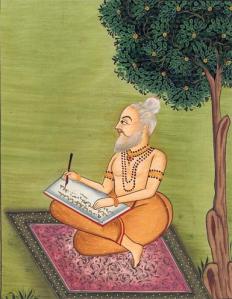 Ratnakar, a robber once tried to rob sage Narad. It was a routine job for him, to kill and rob travelers. But this time was different. Narad asked him, you do all this for your family, but will your family also share the load of your sins. This left Ratnakar deep thinking. He checked with his family and to his surprise, they did not agree to share the burden of his sins, regardless of the luxuries it provided. At this, Ratnakar asked Narad to teach him the right path. Narad told him the story of Lord Ram and also said, you should chant God’s name. But the name he gave was ‘Mara’ (means dead). So Ratnakar started meditating and chanting MARA-MARA-MARA…MA.RA.MA.RA.MA.RAMA.RAMA.RAM….RAM-RAM-RAM-RAM……
Ratnakar, a robber once tried to rob sage Narad. It was a routine job for him, to kill and rob travelers. But this time was different. Narad asked him, you do all this for your family, but will your family also share the load of your sins. This left Ratnakar deep thinking. He checked with his family and to his surprise, they did not agree to share the burden of his sins, regardless of the luxuries it provided. At this, Ratnakar asked Narad to teach him the right path. Narad told him the story of Lord Ram and also said, you should chant God’s name. But the name he gave was ‘Mara’ (means dead). So Ratnakar started meditating and chanting MARA-MARA-MARA…MA.RA.MA.RA.MA.RAMA.RAMA.RAM….RAM-RAM-RAM-RAM……
His chant soon became Lord Ram’s Name. But by the time he could master his worship, he was buried deep in anthills. When he reached the divine stage, the holy voice from heaven told him to rise and gave him a new name: Valmiki (means Ant-hill in Sanskrit).
This robber turned into the biggest saint of all times. It is said that when Lord Rama returned to Ayodhya, he had to disown his pregnant wife. His wife, Sita, took shelter at Sage Valmiki’s ashram. Rishi Valmiki also wrote the famous epic Ramayana and taught it to Sita’s children, Luv and Kush, which they recited in Ram’s court. That’s how their father Ram recognized them and momentarily reunited with his wife Sita.
Since then, hundreds of versions of Ramayan have been written. While most are mere translations, some were written from scratch, according to regional beliefs. The biggest challenge has been that the original Ramayana story was told to Valmiki by Narad and then passed to Luv and Kush. The original text was lost long back but it did travel orally to different regions and cultures. Saints and Poets from all across tried to interpret the epic in their local language. During this interpretation and translation from oral traditions, many aspects of the story were changed. However, one common and most important thing remains constant in all versions: Ramayana is actually a compilation of teaching of ancient Hindu sages. It presents these teachings in a nice narrative, where each character, starting from Lord Rama to Ravana and Sugreev are fundamental to cultural consciousness of the region, where Hinduism was prevailing.
Most importantly, Ramayana is not restricted to Hinduism. Muslims of South India incorporated the message of Ramayana in their poems and the work is called Mappillapattu or Muslim Ramayana. Jains have their own version of Ramayana, where Lakshmana kills Ravana instead of Rama, for which he is pushed to hell along with Ravana. Rama is characterized an upright person who at the end sacrifices his kingdom, becomes a Jain monk and attains Moksha. They also believe that Ravana will one day be born as a Jain Tirthankara.
The Buddhist version is much different from others. Here, King Dashrath was ruling Banaras (Varanasi) and not Ayodhya. He gave birth to Ram, Laxman, and Sita through his first wife. To save these siblings from his second wife, he sent the trio to Himalayas. 12 year later they come and now Ram and Sita became consorts and ruled the kingdom. Interestingly, abduction of Sita has no mention in this version.
Guru Gobind Singh, the 10th spiritual master of Sikhs also wrote the story of Ram in his bani ‘Ath Chaubees Avatar’ in Sri Dasam Granth. Even Guru Granth Sahib mentions characters and message of Ramayana at several places. ‘Salok Mahalla 9’ in Sri Guru Granth Sahib, written by Guru Teg Bahadur (9th Sikh guru) says:
‘Ram gayo, raavan gayo, jaako bahu parivaar, Kahu nanak thir kichh nahi, supne jiyo sansaar’. Means, both Ram and Ravan, who had such big family left this mortal world. Nanak says, nothing is stable. This world is like a dream.
Interestingly, while over 300 versions of Ramayana exist, Maharishi Valmiki is said to have written two versions himself. The other version is called ‘Adbhut Ramayana’, where after killing 10-headed demon Ravana, Lord Rama travels to Pushkar to kill his elder brother, the 1000-headed Ravana. Later in this narration, Sita transforms into Goddess Mahakali or Shakti. The best part is that even Lord Ram prays to Goddess Shakti with 1008 divine names, which glory the virtues and attributes of the Goddess.
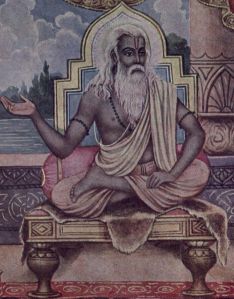 Rishi Ved Vyasa also authored a version of Ramayana, where an entire episode of maid Mantara provoking Queen Kaikayi to send Ram to exile was not an act of cruelty. Goddess Saraswati came as Mantara to play her part in the larger drama of destiny. Ram was born to remove the evils of Ravana, hence Saraswati helped the situation. Since Ram knew of the abduction of Sita, he ensured that Sita had her illusion born of fire in place. Here, all characters and their acts are portrayed as spiritual messages.
Rishi Ved Vyasa also authored a version of Ramayana, where an entire episode of maid Mantara provoking Queen Kaikayi to send Ram to exile was not an act of cruelty. Goddess Saraswati came as Mantara to play her part in the larger drama of destiny. Ram was born to remove the evils of Ravana, hence Saraswati helped the situation. Since Ram knew of the abduction of Sita, he ensured that Sita had her illusion born of fire in place. Here, all characters and their acts are portrayed as spiritual messages.
In Sri Lanka, the version of Ramayana depicts Ravana as Hero. Malaysian version places Dashratha as the grandson of prophet Adam and Ravana receives boons from Allah. Also, Laxman is a hero instead of Ram. In Thai version, Sita is the daughter of Ravana and Mandodry, while Hanuman is the main hero, instead of Ram or Laxman. Despite all these variations, the core message of humanity and spirituality remains same.
The Gandhak ki Baoli and Rajo.n ki Baoli (or Rajo.n ki Bae.n) are famous in Mehrauli. However, very few know about the underground Baoli of Dawood and lost Baoli of Aurangzeb, situated on either sides of Zafar Mahal. To the west of Zafar Mahal, there once existed a Baoli, said to have been built by Aurangzeb. It must now be buried somewhere under the houses. However, Dawood’s strucure is in more accessible shape.
Each day, hundreds of devotees flock to the shrine of Hazrat Khwaja Qutubuddin Bakhtiyar Kaki (r.a.) in Mehrauli, Delhi. Khwaja Kaki was the spiritual successor of Hazrat Khwaja Moinuddin Chisti (ra) of Ajmer. Numerous stories associated with his life make this area more important for devotees. With so many disciples coming in, basic necessities like Caravan Sarai with adequate supply of food and water was very important. It is said that one of the prime disciples of Khwaja, Sultan Iltutmish commissioned a Baoli in Dargah Complex. Situated in the rear of complex, near Majlis Khana, the Baoli today is hidden and hardly known. In 1844-46, a person named Hafiz Dawood spent Rs. 14,000 and built a huge audience hall over the steps of Baoli. He is said to be a favourite of Emperor Bahadur Shah Zafar. The roof of this Baoli is now well covered with marble and appears to be regular floor of Dargah compound, hiding the steps and tank beneath it. A small slit in floor in the south west corner, approached through the maze of few graves, lead you to a flight of steps that result in a locked door. The dedicated manager of Dargah, Janab Fauzan Ahmed, who is trying his level best to keep this Baoli clean and bring it back to life is always more than eager to open this lock for you and make the Baoli more popular.
As the door opens, you reach a hall, built by Dawood. It has huge colonial columns and girders with roof slabs. Another side leads you to the steps, that take you to the tank of Baoli. It was recorded that this Baoli is about 75 feet deep and this depth is scaled with just 74 steps. This 96 feet by 42 feet rectangular structure is built with rubble masonry and panelled recessed arches. The Baoli was open till early 1990s. People used to bath in it. Then it was closed due to some reason.
Towards east, the Well exists, which is open from top and covered by high rise houses on 3 sides. Unfortunately, houses connected to this Baoli used this well as a garbage pit. It was filled with garbage till 2013 and appeared to be totally dry.
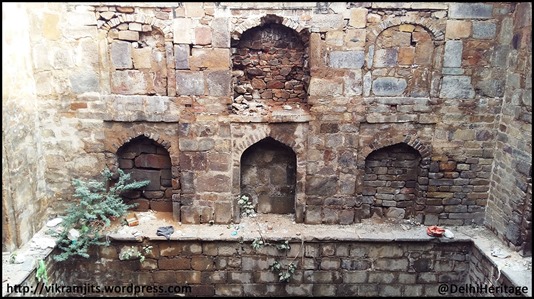
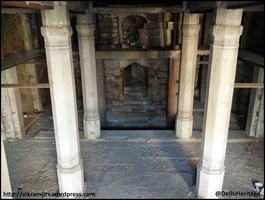
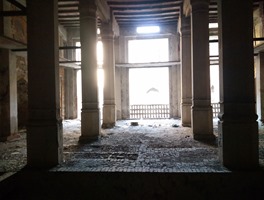

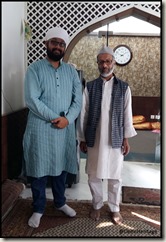 The Baoli was in a bad shape and well was more of a dumping pit. In 2013, government decided to clean it. By November 2013, in just 25 days, they had cleaned 5 meters, or roughly 600 cubic meters waste. During a conversation, I was informed by one of the seniors at Dargah that contractor who was employed by SRDC & PWD to clean Baoli tried to skip hard-work. He offered bribe to Dargah management, to file a report mentioning work completion to satisfaction. However, the honest Manager, Mr. Fauzan (in pic) refused. He returned that money to contractor and asked him to invest it further to clean it. He also informed government officials about this incident. As a result, Contractor had to work further and 5 more feet were cleaned, resulting in the Baoli getting filled with clean water. Had Mr. Fauzan accepted that bribe, this Baoli would still have been dry and dirty.
The Baoli was in a bad shape and well was more of a dumping pit. In 2013, government decided to clean it. By November 2013, in just 25 days, they had cleaned 5 meters, or roughly 600 cubic meters waste. During a conversation, I was informed by one of the seniors at Dargah that contractor who was employed by SRDC & PWD to clean Baoli tried to skip hard-work. He offered bribe to Dargah management, to file a report mentioning work completion to satisfaction. However, the honest Manager, Mr. Fauzan (in pic) refused. He returned that money to contractor and asked him to invest it further to clean it. He also informed government officials about this incident. As a result, Contractor had to work further and 5 more feet were cleaned, resulting in the Baoli getting filled with clean water. Had Mr. Fauzan accepted that bribe, this Baoli would still have been dry and dirty.
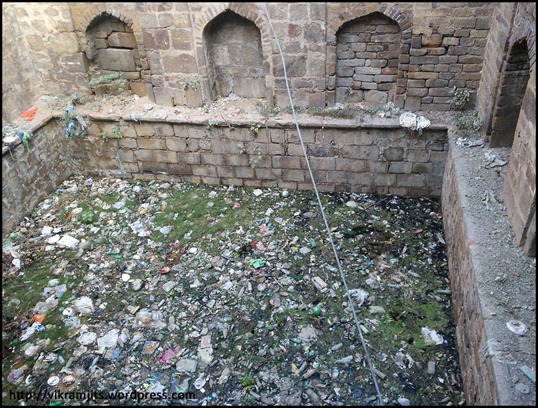
We also find traces of some restoration work done by end of 1800s or early 1900. This is confirmed by the use of an iron girder, that bears the date 1898.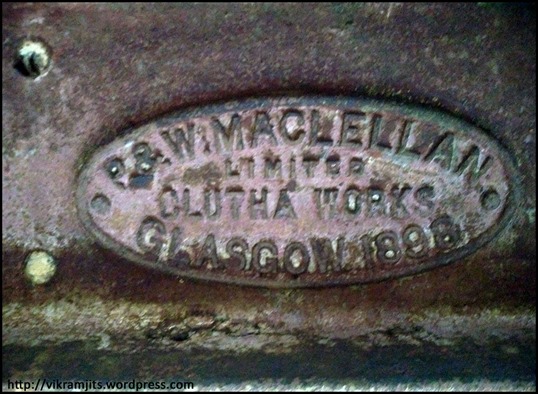
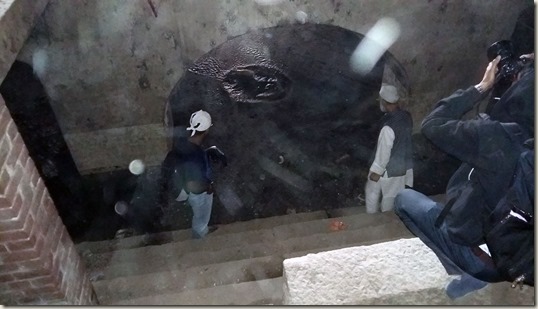
This article originally appeared in NRI Achievers Magazine October 2016 Issue
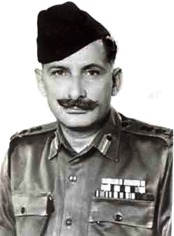 American Uncle Sam is famous across globe. India had her own Uncle Sam, who came from a Parsi family and was once the most powerful man in country. He was popularly known as Sam Bahadur and made India proud at many fronts. This article is about Padma Vibhushan Field Marshal Sam Hormusji Framji Jamshedji Manekshaw, the commander in chief of Indian Army.
American Uncle Sam is famous across globe. India had her own Uncle Sam, who came from a Parsi family and was once the most powerful man in country. He was popularly known as Sam Bahadur and made India proud at many fronts. This article is about Padma Vibhushan Field Marshal Sam Hormusji Framji Jamshedji Manekshaw, the commander in chief of Indian Army.
Born on 3rd April, 1914 to Captain Dr. Hormusji Manekshaw and Hilla in Amritsar, Sam was 5th of 6 children. He completed his education from Amritsar and from Nainital and joined Sherwood College. Wanting to become a gynaecologist, he requested his father to send him to London. But his father refused. He was unhappy with this and in those days, Field Marshal Sir Philip Chetwode was in process of setting up the Indian Military Academy. As an act of rebellion, Sam became part of IMA’s first intake against his father’s will.
During his IMA days, he appeared to be the most witty and notorious cadet. He had many firsts credited to his name like the first Gentleman Cadet (GC) to be awarded an extra drill and first GC to ask for a weekend leave. He was one of the first 22 cadets to graduate from IMA and commissioned as Second Lieutenants on 1st February 1935. Along with him, Muhammed Musa and Smith Dun also graduated, who later became the Army chiefs of Pakistan and Burma respectively, while Sam Bahadur took over as 8th Army Chief of India. General Manekshaw also became the first Indian Field Marshal.
Sam Manekshaw has always been the most outspoken and witty officer. Some of his statements have become history. Here are few:
1. On June 8, 1969, on the centenary of Sherwood College, speaking of his days at college, Sam said “College had prepared me for war in World War II as I learnt here to live alone and independently, to fight without relent, tolerate hunger for long periods and to hate my enemy.”
2. Speaking of Indian Army’s Gurkha Regiment (which he joined after passing out IMA), Sam said: “If anyone tells you he is never afraid, he is a liar or he is a Gurkha”.
3. When Prime Minister Indira Gandhi asked about readiness of Indian Army for 1971 war, he said “I am always ready sweetie”
4. One of his most apt comment was on politicians, when he said “I wondehe said “n politicianssidleger and then moved to Nainital and joined Sherwood College. This article is about most powerr whether those of our political masters who have been put in charge of the defence of the country can distinguish a mortar from a motor; a gun from a howitzer; a guerrilla from a gorilla, although a great many resemble the latter.”
5. During 1962 Indo-China war, Indian soldiers were retreating and Sam Bahadur was sent to command this army. He reached there and said: “Gentlemen, I have arrived and there will be no withdrawal without written orders and these orders shall never be issued.”
6. During Indira Gandhi’s tenure, there was a rumour that Army has grown so big that they will soon takeover. Prime Minister called Manekshaw and asked her about these rumours. Sam looked into her eyes and said: “You mind your own business and I mind mine. Your kiss your own sweetheart and I’ll kiss mine. I don’t interfere politically, as long as nobody interferes with me in the army.”
7. Manekshaw was his with 7 bullets during a battle and when he was taken to hospital, doctor tried to engage him in a conversation. He asked Sam what happened, to which he replied in his own witty style: “I was kicked by a donkey.”
8. He said “Pakistan would have won the 1971 war” when some reported asked him, what if he would have joined Pakistan along with the regiment he was serving in 1947.
9. In Mizoram, there was an armed conflict and the commanding officer was avoiding it. General Manekshaw sent him a pack of bangles with a note that read: “If you are avoiding contact with the hostile, give these to your men to wear.” The commanding officer then decided to get into battle with his unit and returned victorious. He was then presented with another note from the General that read “Send the bangles back.”
10. Indira Gandhi wanted to go on a war with Pakistan immediately but Manekshaw was asking for few months of preparation. When the ministers sitting in meeting pressurised him to get into action immediately, he protested verbally. Mrs. Gandhi requested everyone to step out of room and had a dialogue with Sam Manekshaw in private. As everyone left, Sam said: “Prime Minster, before you open your mouth, would you like me to send in my resignation on grounds of health, mental or physical?”
11. Before partition, Yahya Khan was working with Manekshaw in same unit. He purchased Sam’s motorcycle for Rs. 1000, which was never paid. During 1971 war, Yahya Khan was the president of Pakistan. After India stood victorious and Bangladesh was born, Manekshaw said: “Yahya never paid me the Rs. 1000 for my motorbike, but now he has paid with half his country.”
12. General Sam wanted to ensure that Indian Army never indulges in the brutal trends of victorious armies to spoil and dishonour the women of defeated land. So he instructed his men during 1971 war that “When you see a begum, keep your hands in pocket and think of Sam.” As a result, there was not even a single case of robbing/dishonouring by Indian Army.
13. When some ministers in a meeting objected that Sam always address Indira Gandhi as Prime Minister and not as ‘madam’, he reminded them that the title ‘madam’ is reserved for the head lady of a brothel.
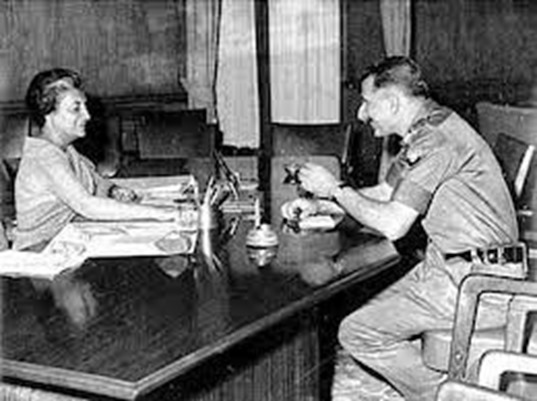
Although Sam was one of the most powerful, brave and jolly general we had, his style of speaking to politicians made some of our leaders uncomfortable. As a result, he was denied all the post-retirement privileges and was not even given due salary. It was only after President A.P.J. Abdul Kalam met him and ensured that his arrears of 30 years are cleared and he was then presented a cheque of Rs. 1.3 crore. On June 27, 2008, at the age of 94, Field Marshall Sam Manekshaw passed away in Military Hospital in Wellington (Tamil Nadu) due to complications from Pneumonia. He was put to rest in Parsi cemetery in Ooty, but his funeral was not attended by any politician or even military top brass.
We are all aware of the two houses, Rajya Sabha and Lok Sabha, of the Indian Parliament. However, if you look at the design of Parliament, it has Four halls instead of two. Three halls on sides for the houses of Parliament and the fourth one in centre, for the joint session. Originally, Indian Parliament, or the Council House as it was termed then, was comprising of 3 houses. The State Council, Central Legislative Assembly and the Chamber of Princes.
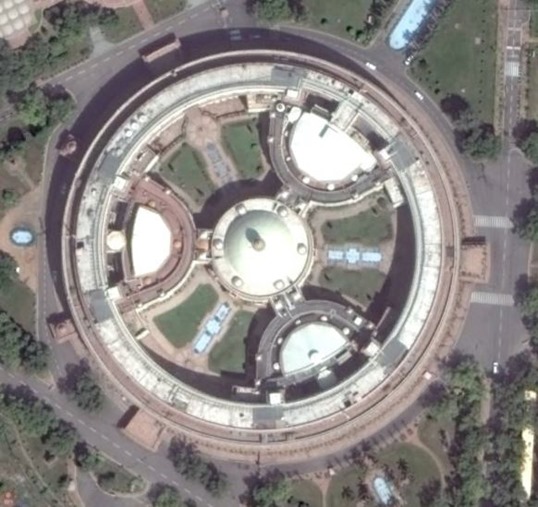
Council of State originally had 60 members when it started in 1919. The Viceroy or the Governor General of India was its ex officio president. In 1937, its size was increased to 260 members and in 1947, it was dissolved, to be later taken over by Constituent Assemblies of India and Pakistan respectively. Today, this upper house in India is known as the Rajya Sabha.
The Central Legislative Assembly, or the lower house, originally had 145 members representing different provinces of India. Out of these, 103 were elected, and rest nominated by upper house. Of these 103, 51 came from general constituencies (30 by Muslims, 2 by Sikhs, 9 by Europeans, 7 by Landlords and rest by businessmen). It was abolished on 15th August 1947 until in 1952, as India became republic, the Legislative Assembly was renamed as Lok Sabha and became functional under the new Constitution of India. Though its members are still known as MLA (Member of Legislative Assembly).
Then comes the third house, which was also abolished in 1947. While Council of State and the Legislative Assembly merged into the Constituent Assembly and later remerged as Rajya Sabha and Lok Sabha respectively, this one house had no representation left in the new independent system of Republic of India. Hence, on 15th August, 1947, as India was divided into Dominion of India and Dominion of Pakistan, this one powerful house was abolished and forgotten for ever. This house was the Chamber of Princes, or the ‘Narendra Mandal’. It was established in 1920 by a royal proclamation of King Emperor George V, so that the princely states can have their say in the administration of India and voice their needs to the British crown. This decision was one of the most important decisions as it abolished the British policy of isolating Indian princely states from each other.
House first met on 8th February 1921. Initially, it had 120 members. Of those, 108 were representing major states, hence were members in their own right. While remaining 12 were elected to represent 127 smaller states. This left 327 minor states with no representation. Also, major states like Baroda, Gwalior and Holkar refused to join it. They met only once a year, with an appointed standing committee meeting more often. The house appointed a Chancellor as head of the house. The first chancellor was Major General His Highness Sir Ganga Singh, Maharaja of Bikaner, who presided over the house from 1921-1926. His successors were Adhiraj Major General His Highness Sir Bhupinder Singh, Maharaja of Patiala (1926-1931), Colonel His Highness Sir K. S. Ranjitsinhji, Maharaja of Nawanagar (1931-1933), Colonel His Highness Sir K. S. Digvijaysinhji, Maharaja of Nawanagar (1933-1944), Hajji Major General His Highness Sir Hamidullah Khan, Nawab of Bhopal (1944-1947).
In 1940, as the discussion of Indian Independence was gaining momentum, the Chamber of Princes felt its heat and convened in the month of March. On 12th March 1940, they resolved:
“The Chamber of Princes, while welcoming the attainment by India of its due place among the Dominions of the British Commonwealth under the British Crown, records its emphatic and firm view that, in any future constitution for India, the essential guarantees and safeguards for the preservation of the sovereignty and autonomy of the States and for the protection of their rights and interests arising from treaties, and engagements and sanads or otherwise, should be effectively provided and that any unit should not be placed in a position to dominate the others or to interfere with the rights and safeguards guaranteed to them, and that all parties must be ensured their due share and fair play; And that, in any negotiations for formulating a constitution for India, whether independently of the Government of India Act 1935, or by revision of that Act, representatives of the States and of this Chamber should have a voice proportionate to their importance and historical position.”
Despite of this resolution, the chamber was dissolved and never revoked. Instead, the princely states were annexed into the Dominion of India and Dominion of Pakistan one after another the hall dedicated for Chamber of Princes was later converted into Parliament Library. As a compensation, a Privy Purse was established.
The Privy Purse was a payment made to the royal families of erstwhile princely states after they agreed to merge their state with India and lost all ruling rights. In 1947, the states were required to sign the instrument of accession with India and cede defence, communication and foreign relations to India. Later, in 1949, most of these states were completely merged. The amount of privy purse was determined by several factors, including the revenue of state, gun salute enjoyed during British Raj and antiquity of dynasty etc. While the smaller states were given a privy purse allowance, as low as Rs. 5000 per annum, states like Hyderabad, Mysore, Travancore, Baroda, Jaipur and Patiala received a privy purse above Rs. 10,00,000. 102 privy purse were between 1-2 lakh rupees. Government of India kept reducing the privy purse with every succession in family.
When Prime Minister Indira Gandhi abolished the Privy Purse in 1971, rulers of erstwhile states decided to contest in elections, hoping that their subjects would elect them into parliament, where they can voice their needs properly. However, most of them were left red faced after shameful defeats with huge margins. Popular rulers, like Nawab Mansoor Ali Khan Pataudi could earn only 5% of total votes, in a 2-way contest.
Finally, the Privy Purse came to an end. Many of the nawabs and kings became more active in politics, while others went to start their business.
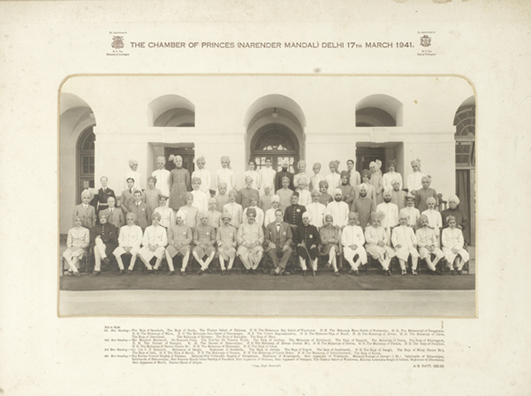
THIS ARTICLE APPEARED IN NRI ACHIEVERS’ JULY-2016 EDITION
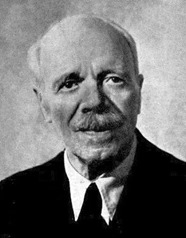 This month, we celebrate the birthday of a fearless hunter, who turned into a saviour for tigers in India. I came across this story while I was sitting on the shore of Kosi River of Uttarakhand.
This month, we celebrate the birthday of a fearless hunter, who turned into a saviour for tigers in India. I came across this story while I was sitting on the shore of Kosi River of Uttarakhand.
Few days back, I went to Namah Resorts in Dhikuli, Jim Corbett Park. I was interested in the lost temple of Vairapattana, which was supposed to be around this resort. I stayed there for few days, enjoyed the impeccable hospitality, and kept enquiring about the lost Shiva Temple. They pointed me to a direction and surprisingly, at mere 300 steps, I found the remains of Ancient Shiva Temple. My mission was complete, but during my discussions with staff and naturists at this resort, I learned few more things about the area.
One of the resident experts at Namah Resort asked me, if I know about Jim Corbett. I replied with a smile, “Yes! You made us interact with Mr. Imran Khan, the best known naturists in Jim Corbett National Park. He told us everything about flora and fauna.” He continued, ‘No Sir, I meant, James Edward Corbett’. I was quite. I have heard of him, but why is this gentleman emphasising so much. He praised Corbett and we retired to our room appreciating the spectacular sunset view across Kosi river. As I reached my room, I started reading about Colonel James Edward Corbett of the British India Army. By this time, Namah team sent me a wonderful Mocktail as reward for participating in one of their contests. Sipping this mocktail in the balcony of my cottage, I paid my homage to Google Baba and got started.
Colonel Corbett was born in Nainital in 1875 to the postmaster of Nainital, William Christopher Corbett. He spent his entire childhood in the region. During winters, the James Corbett with his other 15 siblings and parents used to stay in their family home downhill, what we now know as Corbett’s Village or Kaladhungi. After schooling, he was employed by Railways. He was so well versed with the jungle, that he could identify most animals and birds by the sounds they make. Soon, he became famous as the hunter, who would save locals from man eating tigers and leopards. His most famous kill was the tiger known as Bachelor of Powalgarh. Powalgarh is a connected reserve near Ramnagar. We were taken to Powalgarh the next day to show the site, where Corbett killed this tiger. We also have the largest tree trunk of this region in the vicinity. Corbett wrote a book titled ‘Man Eaters of Kumaon’. He mentions of several kills that he made and how he accomplished those victories. Interestingly, the only one to accompany him was his favourite dog ‘Robin’. His expeditions were all on foot. His book talks about the strategies he made to hunt man eaters in Champawat, Thak, Muktesar, Chowgarh, Rudraprayag, Kanda, Pipalpani and many more. The Panar Leopard was known to have killed as many as 400 people, before being slayed by Corbett.
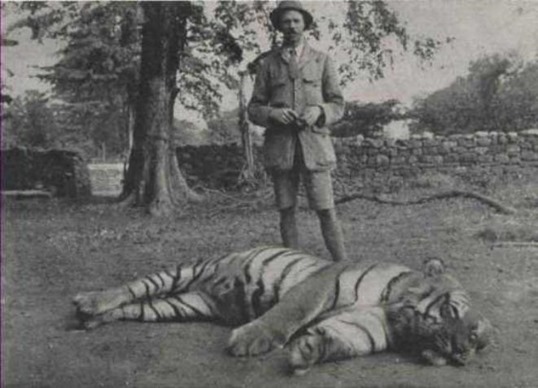
When Corbett analysed his kills, he found out that most of the man eaters had porcupine quills embedded deep in their feet. Some even had un-healed gunshot wounds. While I was discussing this with our nature expert at the Namah Resort, he explained that years of research has revealed that porcupine is the most common reason for tiger’s pain, unrest and forcing him to target slow moving targets like humans. Jim Corbett, when realized this, turned into a saviour of animals. He bought a camera and started filming tigers. I met James Champion a while back. He is son of Frederick Walter Champion, companion of Jim Corbett in his expeditions to understand and save tigers. He gave me few insights on how Corbett turned into a conservationist and led campaigns to protect tigers. Corbett and Champion established India’s first nature reserve, the Hailey National Park in 1936. It was named after Lord Hailey, governor of United Provinces (now Uttarakhand and Uttar Pradesh) from 1928 to 1934. His efforts laid the foundation of Project Tiger of Government of India, which helped us realize the reducing number of tigers and forced to take measures to save them. Today, his Hailey National Park covers 520 square kilometres of hill area near Nainital (Originally it was 323 sq. Km). It houses around 110 tree species, 50 species of mammals, 580 bird species and 25 reptile species. Initially, the proposal was to make it a Game Reserve, where British could come and enjoy hunting as a sport, while animals move freely. Princely state of Tehri Garhwal had already cleared most of this forest to save from invading Rohillas. When land came completely under British and restoring forest was underway, Jim Corbett played an important role to ensure that it stays as a Nature Reserve and not a Game Reserve. He emphasized on protecting the Tigers. He told, how careless hunting activities are turning tigers into man-eaters. His efforts were fruitful and the park was established. Later, in 1954 it was renamed as Ramganga National Park. But within 3 years, the Independent Indian Government gave credit to Jim Corbett and renamed this oldest national park of India as ‘Jim Corbett National Park’.
Until 1947, Corbett and his sister lived in Gurney house in Nainital. The house was sold to Mr. Sharad Prasad Varma, which is now passed to his granddaughter Ms. Nilanjana Dalmia. Corbetts retired to Kenya, where Jim Corbett kept working hard to protect the wildlife. He was escorting Princess Elizabeth of England during her Kenya visit and they were staying in Tree Tops Hotel when King Geroge VI passed away. Next morning, when Elizabeth was told about this incident, she came down from Tree Tops and left for England as a Queen. Corbett wrote the famous lines that day in the visitor log book of Tree Tops:
For the first time in the history of the world, a young girl climbed into a tree one day a Princess, and after having what she described as her most thrilling experience, she climbed down from the tree the next day a Queen—God bless her.
He passed away on 19th April, 1955. We celebrate Corbett’s 231st birthday this 25th July.
– Vikramjit Singh Rooprai
When Mughal conquered India, they adopted the Indian lifestyle and respected religion of locals. From Akbar offering Chhatar to Hindu temples and donating land for Golden Temple of Sikhs, each Mughal emperor was involved in some or other interfaith activity. The communal unity was at its peak with many Jain, Hindu and Sikh nobles serving in the Mughal court. British realized this strength of Indian people and decided to implement their Divide and Rule policy. They identified Aurangzeb as the pivot, during whose rule, maximum forceful conversions and temple destruction took place. The fact that these incidents happened only in the areas where Hindu/Sikh groups started mutiny against Mughal crown was deliberately removed from History books. It was projected that Mughals, especially Aurangzeb were always bad. Following their Divide and Rule policy, all events that exhibit Hindu Muslim Unity were banned, including the one I am going to talk about today:
It was year 1812. East India Company had penetrated to Mughal court completely and a Resident Officer was living inside the Red Fort, controlling the administration of India. Coins were struck by British Mints and name of Mughal Emperor was removed from currency. Emperor Shah Alam II had died, for whom people started saying
‘Badshah Shah Alam, Az Delhi, Ta Palam’
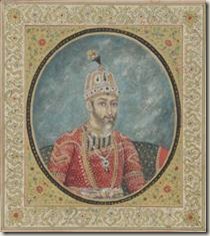 It meant, Emperor Shah Alam’s rule is from Delhi (Red Fort) to Palam (present day Delhi Airport) only. Shah Alam II’s son, Akbar Shah II was the puppet king and Archibald Seton, a Scottish East India Company Administrator was the appointed Officer in Red Fort. Next in line to throne, Crown Prince Mirza Jahangir was against British way of working. One day, this reckless young prince of 19 insulted Seton by calling him Lullu. Seton did not react then. Perhaps he did not understood the meaning of the word. Few days later, when Seton was returning from court, Mirza Jahangir, sitting on the roof of Naubat Khana, fired a shot at him, missing Seton completely. While Seton escaped unhurt, his orderly lost his life. Angry with this, British arrested Mirza Jahangir and sent him to Allahabad fort. Back then, it was famous that a political prisoner, who is sent to Allahabad Fort, never returns alive.
It meant, Emperor Shah Alam’s rule is from Delhi (Red Fort) to Palam (present day Delhi Airport) only. Shah Alam II’s son, Akbar Shah II was the puppet king and Archibald Seton, a Scottish East India Company Administrator was the appointed Officer in Red Fort. Next in line to throne, Crown Prince Mirza Jahangir was against British way of working. One day, this reckless young prince of 19 insulted Seton by calling him Lullu. Seton did not react then. Perhaps he did not understood the meaning of the word. Few days later, when Seton was returning from court, Mirza Jahangir, sitting on the roof of Naubat Khana, fired a shot at him, missing Seton completely. While Seton escaped unhurt, his orderly lost his life. Angry with this, British arrested Mirza Jahangir and sent him to Allahabad fort. Back then, it was famous that a political prisoner, who is sent to Allahabad Fort, never returns alive.
 The Mughal court tried its best to save him, but the administration was in British hands completely. Having failed at every door, Empress Mumtaz Mahal, mother of Mirza Jahangir came to the shrine of Sufi Saint Khwaja Qutubuddin Bakhtiyar Kaki (ra) in Mehrauli, Delhi. She took a vow that if Mirza Jahangir returns safely, she would offer a sheet (chadar) of flowers at the Dargah.
The Mughal court tried its best to save him, but the administration was in British hands completely. Having failed at every door, Empress Mumtaz Mahal, mother of Mirza Jahangir came to the shrine of Sufi Saint Khwaja Qutubuddin Bakhtiyar Kaki (ra) in Mehrauli, Delhi. She took a vow that if Mirza Jahangir returns safely, she would offer a sheet (chadar) of flowers at the Dargah.
After few years of praying, Mirza Jahangir one day miraculously returned to the Red Fort. The Empress approached Emperor Akbar Shah II and told him about her vow. Emperor was more than happy to be a part of pledge. They both decided to start from the Red Fort with sheet of flowers for the Shrine. News spread like jungle fire and everyone in and around the Palace got ready to walk with the royal family, to pay homage to Sufi Saint resting in Mehrauli.
It was the month of September. Convoy started with all the praise singing and merry making. When they reached the outskirts of Mehrauli, Mughal Emperor stood by the Temple of Ma Yogmaya and said, Mehrauli is known for this deity and it will be a sin to pay respect to Sufi Shrine and not visit the Hindu Temple.
Yogmaya Temple in Mehrauli is considered to be one of the Temples Pandavas built. It is attributed to Maa Yogmaya, sister of Lord Krishna, who was replaced with Krishna upon birth to save him from his evil uncle Kans. This temple gave this area its name ‘Yoginipura’. She is also known as Maha Maya or Mehraa.N waali maayi (mother of graces) and some say, the name ‘Mehrauli’ is a distorted version of ‘Mehra.N Waali’ (NOTE: Mehra-waali = Mehravali = Mehrauli).
Emperor Akbar Shah II entered the Hindu Temple and offered a Pankha (fan) to the deity. He then went to the Muslim Shrine to fulfil rituals of offering Chadar. For seven days, entire court was shifted to Mehrauli and with all the merry making and celebrations, people were very happy. Emperor ordered to repeat this event every year. A palace, called Rang Mahal was constructed as every year, entire Mughal court used to get shifted to Mehrauli for 7 days. Every year, Mughal Emperor would come with everyone from Red Fort and around, with a sheet of Flowers and a decorated Fan for Temple. This festival became popular with name ‘Phoolwalo.N ki Sair’ or ‘Sair-i-Gul-Farosha.N’.

Rang Mahal was later termed as Lal Mahal. Mirza Jahangir could never become king. Instead, his brother, who was a poet and had no interest in ruling the country, Mirza Sirajuddin aka Badshah Bahadur Shah ‘Zafar’ was made emperor. Zafar added portion to this palace and it is today popular with name Zafar Mahal.
Emperor Akbar Shah II and his family got buried in this Zafar Mahal, next to the shrine. Emperor Zafar also designated a place for his grave next to his father, but since he was exiled to Rangoon, he could never return and fulfil his last wish.
In early 1940s, British imposed ban on all activities that exhibited communal harmony. So was the fate of Phoolwalon ki Sair. It was stopped for almost 2 decades, until in 1961, Pt. Jawaharlal Nehru asked the mayor of Delhi, Mr. Nooruddin Ahmed and a scion of prominent family Shri Yogeshwar Dayal to revive the festival. On September 6, 1962, Pt. Nehru played the part of the Mughal Emperor and the festival was celebrated like old days. He continued to do so until his death, after which, his daughter Indira Gandhi took special interest in the festival. She invited other states of India to participate, so that the festival of Communal Harmony becomes the festival of National Communal Harmony.
Phoolwalon ki Sair is celebrated till date, for 7 days, every September. It is managed by Anjuman-i-Sair-e-Gulfaroshan, a society governed by notable Hindus and Muslims of Mehrauli. Pankha and Chadar are offered by President, Prime Minister, Chief Minister of Delhi, Lt. Governor of Delhi and different state governments. Pity, that we are too busy in propagating religious biasness, that we pay no attention to such celebrations.